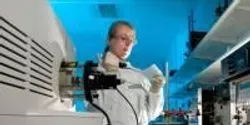
CURRENT ISSUE | VOLUME 8 - ISSUE 4 | May 2013
COVER STORY
Is Your Message Getting Lost in the Sauce?
Choosing and using the best communication channels for your team
Leadership and Staffing

Dawn is arriving. The crisp aroma of meadow flowers fills the air and the crowd inhales deeply to capture the scent, if only for a moment. They wait. Backlit by the rising sun, the anointed leader surges into view and a mighty cheer erupts from the crowd, deafening in the celebration of their chosen leader. Raising a hand, asking for quiet attention, the leader guides the prancing steed, resplendent in silver and highly polished leather, up and down the front lines, looking deeply into the eyes of those who have chosen to follow.
Business Management
Laboratory Technology
Ask the Expert
Lab Health and Safety
Lab Health and Safety Tips
Product Focus
Time to Upgrade?
INSIGHTS
Research-Specific Labs
Surveys

Many labs or their parent organizations maintain dedicated plants to transform municipal water into a product labs can trust for routine jobs. To take water to the next level requires a separate, additional process. Successful water system designs begin with clear, precise definitions of user needs.

While titration is a basic analytical method, titrators are specialized instruments that perform titrations with minimal operator intervention. They can thus minimize errors, improve throughput, and facilitate documentation. There are two major titrator types: potentiometric acid-based designs and Karl Fischer titrators.

Automated liquid handling (ALH) systems span the range from semi automated multichannel pipettors to room-sized systems. The industry is trending toward versatile, modular ALH systems—seemingly for every budget. Likewise, instrumentation, software & methods have followed the trend toward greater user accessibility.
How it Works

Problem: The University of Rochester was looking to rebrand itself and increase student enrollment, particularly in the Science and Engineering Department. The university’s president understood that in order to achieve this goal, they needed to improve the school’s attractiveness to undergraduate science majors. Although the university had been gaining well-deserved respect for their graduates, the lack of innovative and updated lab facilities was a serious factor in hindering undergraduate enrollment. The current chemistry lab had been regularly upgrading its equipment, but it failed to update the physical workspace. Long counters filled small rooms with drab-colored walls. The design was functional but it was far from a state-of the-art laboratory.

Problem: In today’s laboratories, safe, efficient sample processing is essential to getting research answers faster. The centrifuge is a staple of these laboratories and critical to this sample processing. Often a shared resource in busy research facilities, the lab centrifuge can be a revolving door of multiple users with varying levels of experience and a range of applications, all requiring a variety of rotors. Yet, the centrifuge is technically complex and can be the source of lab mishaps if used improperly. These everyday challenges can keep lab managers up at night: Are all researchers trained on centrifuge use? Are they using the right rotors for their applications and is the centrifuge programmed with the correct application parameters? Are they ensuring the rotors are properly and safely secured in the centrifuge chamber to avoid any potential rotor accidents?
















